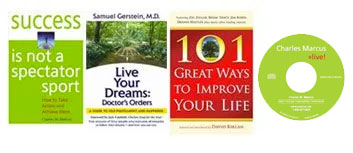In This Edition
1. A Lesson in Speaking In Public
2. A Short Course In Human Relations
3. Quotes
4. Recommended Reading
A Lesson In Speaking In Public
(An excerpt from Charles’ upcoming book: Success Is Not A Spectator Sport)
“I couldn’t deliver a speech to save my life. Before reading my first speech in front of a few hundred GE executives in Cooperstown, N.Y., I twice had to leave the front row of the auditorium to run to the bathroom.” Jack Welch, former CEO of General Electric and author of Jack: Straight from the Gut
Speaking in public is widely acknowledged as the number one social fear in the world. Some people say they would rather die than stand up in front of an audience. That may sound a bit extreme, but public speaking is a major fear and concern to a lot of people, and many do go to great lengths to avoid having to speak in public.
Speaking in public can mean anything from having to give a sales presentation at a meeting or to a prospective client, to having to introduce yourself or make an introduction at a social or business function in front of a group. It can mean having to give a speech at a wedding or happy gathering, or a eulogy at the funeral of a loved one or close friend.
A lot of you may be thinking, “That is fine, but I never find myself in a public speaking situation.” But as my professional colleague, Patricia Fripp, said, “All speaking outside of the privacy of your own home is public speaking.”
Five key points for keeping you on track when speaking in public
1. Know your audience.
Whenever possible, find out as much as you can about your audience. The more you know about their interests, challenges, concerns, and motivations, the more prepared you will be for what may come up. But when in doubt, be prepared for anything.
2. Capture their attention immediately.
The first 60 seconds and the last 60 seconds are going to have the most impact on your presentation, so come out punching, grab their attention, and close with a call to action.
3. Have a structure or approach to what you are saying.
Nothing is going to lose the attention of your audience more quickly than rambling on aimlessly. Make sure that what you are saying flows and has a structure to it, so that people can understand what you are trying to tell them.
Take time to plan out what you are going to say. Where possible link your point to your audience’s motivations and interests.
4. Apply the rules of non-verbal communication.
I believe that effective communication is 20% of what you know, and 80% of the passion you feel about what you know. Passion is heard in the tone of voice you use, in your enthusiasm, and seen in your body language. To repeat: people will forget a lot of what you tell them, but they will never forget how you made them feel in their heart.
5. Remember your goal.
Your objective can be one or more of the following:
√ To inform and educate
√ To connect emotionally as well as intellectually
√ To inspire
√ To entertain
√ To call to action
As you speak, remember which of these you are trying to accomplish and adjust your style accordingly.
And Remember:
√ Speak with clarity, so that people can understand your message
√ Speak with conviction, so that people believe your message
√ Speak with confidence, so people feel inspired and moved to action by your message.
A Short Course In Human Relations
“ The 6 most important words: I ADMIT THAT I WAS WRONG. The 5 most important words: YOU DID A GREAT JOB! The 4 most important words: WHAT DO YOU THINK? The 3 most important words: COULD YOU PLEASE. The 2 most important words: THANK YOU!! The most important word: WE. The least important word: I.”
Author Unknown.
Quotes
“All the adversity I’ve faced in my life, all the troubles and obstacles, have strengthened me….You may not realize it when it happens, but a kick in the teeth may be the best thing in the world for you” Walt Disney
“Everyone has a talent. What is rare is the courage to follow that talent to the dark place where it leads”
Erica Jong
“Always keep an eye on tomorrow, but stay focused on today” Charles Marcus
Recommended Reading
Kate’s Journey: Triumph Over Adversity by Kate Adamson
This very honest and moving book shows us how to meet our challenges with grace and courage. Kate Adamson survived one-in-a-million odds to enjoy the success she has today, surviving a double brain-stem stroke at the age of thirty three. This book will capture your heart. I know it did mine.
30 Days To A Happy Employee by Dottie Bruce Gandy
This book shows how a simple program of acknowledgment can build trust and loyalty at work. The author, a former regional director with the renowned Franklin Covey Company, provides principle-based solution’s that will work to solve the problem in any business.
Living the 7 Habits: The Courage To Change by Dr. Stephen R. Covey
Dr Covey shows us how successful people have used these principles to solve problems, overcome obstacles, and change their lives. By showing how real people have used the principles to thrive in a changing world, he provides practical guidance and inspiration to readers searching for a more meaningful life.







